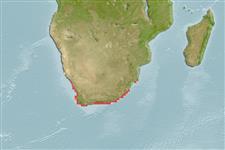>
Blenniiformes (Blennies) >
Clinidae (Clinids)
Etymology: Muraenoclinus: Latin, muraena = morey eel + Greek, klinein, kline = sloping and bed, due to the four apophyses of sphenoid bone (Ref. 45335).
More on author: Bleeker.
Environment: milieu / climate zone / depth range / distribution range
Ekologi
laut dasar (demersal). Subtropical; 27°S - 35°S
Southeast Atlantic: Lüderitzbucht, Namibia to southern Natal, South Africa.
Size / Weight / umur
Maturity: Lm ? range ? - ? cm
Max length : 10.0 cm TL jantan/; (Ref. 5496)
deskripsi pendek
Kunci identifiaksi (pengenalan) | Morfologi | Morfometrik
Duri punggung (Keseluruhan (total)) : 41 - 48; duri punggung lunak (Keseluruhan (total)) : 1; Duri dubur: 2; Sirip dubur lunak: 25 - 31. Color varies from green to brown, occasionally mottled; ocellus on shoulder; preserved specimens uniform buff (Ref. 5496).
Live among stones in tidal pools. Viviparous (Ref. 51409).
Life cycle and mating behavior
Kematangan | Reproduksi, perkembang biakan | Pemijahan | telur-telur | Fecundity | Larva
Smith, M.M., 1986. Clinidae. p. 758-769. In M.M. Smith and P.C. Heemstra (eds.) Smiths' sea fishes. Springer-Verlag, Berlin. (Ref. 5496)
Status IUCN Red List (Ref. 130435: Version 2024-2)
ancaman kepada manusia
Harmless
penggunaan manusia
Alat, peralatan
laporan khas
muat turun XML
Sumber internet
Estimates based on models
Preferred temperature (Ref.
123201): 16.1 - 24.4, mean 20.1 °C (based on 72 cells).
Phylogenetic diversity index (Ref.
82804): PD
50 = 1.0000 [Uniqueness, from 0.5 = low to 2.0 = high].
Bayesian length-weight: a=0.00513 (0.00223 - 0.01182), b=3.06 (2.86 - 3.26), in cm total length, based on LWR estimates for this (Sub)family-body shape (Ref.
93245).
Trophic level (Ref.
69278): 3.3 ±0.4 se; based on size and trophs of closest relatives
Daya lenting (Ref.
120179): sedang, Waktu penggandaan populasi minimum 1.4 - 4.4 tahun (Fec = 237).
Fishing Vulnerability (Ref.
59153): Low vulnerability (10 of 100).
